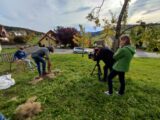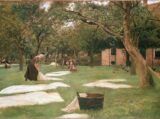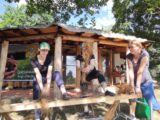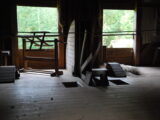The children of a farm were firmly scheduled helpers in the farming year. Many tasks related to flax cultivation were in the hands of children. For many a farmer's child, the work was a chore, but it also marked transitions. Depending on their age, the budding farmer or young farmer's wife was assigned other tasks. Of course, this also made them proud.
Before the field could be cultivated, the Mühlviertel farmer called the whole family to "Stoaglaubm" (fetch stones from the field) As the soil was often poor and very stony, and the flax needed a very nice seedbed, all hands were needed to pick up small and large pieces of stone, throw them on a cart and later store them at the "Glaubstoahaufen" (stone pile). The stones were not waste but building material and were used for all kinds of projects on the farm. To this day, Mühlviertel locals remember this monotonous work that had to be done from childhood onwards.
After cultivation, the next job awaited women and especially girls - "Hoagrosen" (flax weeding). Boys were only called in if there were not enough female labourers on the farm. Only older children usually helped with the later harvest. The little ones then got their turn at "Boinhiaten" (tending the seed pods). After riffling, the unripe seeds were laid out on large cloths to ripen. As the fat seeds are also a favourite bird food, it was the younger children's job to chase away any bird that got too close to the valuable seeds.
The children were also responsible for looking after the flax stalks laid out for roasting. In some regions, the flax straw was watered during long periods of drought in order to speed up the roasting process. This meant carrying water to the field and hoping that the stream or well was not too far away. The children were also responsible for turning the stalks so that the roasting could proceed evenly.
The little ones were mostly just onlookers during the breaking and panting. However, the finished woven linen fabric then made them work again. Before bleaching, the children had to cut out all the dandelion plants in the bleaching meadow. This is because if the dandelions were to rise under the linen, they would leave stubborn stains. As soon as the long lengths were stretched out, the water came into play again. The fabrics had to be wet once or twice a day in order to bleach quickly in summer. Again, this was typical children's work, which was often done together in larger groups.
After all, flax was just one crop that required labour and there were many other jobs that children had to do alongside school and learning. Children therefore took on responsibility for the well-being of the whole family at a very early age. Nevertheless, many farmers' wives remember the time with fondness, as they got up to a lot of nonsense together with the other children from the neighbouring farms at "Boinhiaten".








